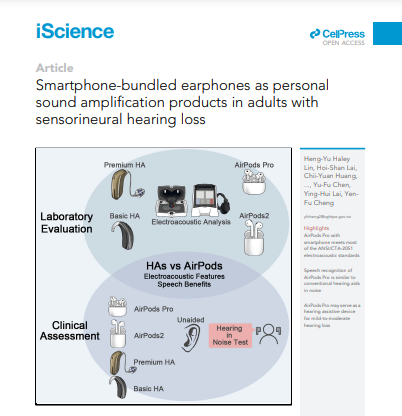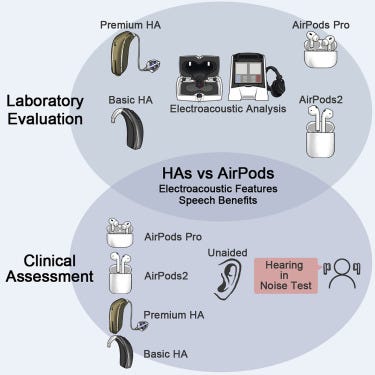Health Transformation Institute (HTI)
research institute & knowledge portal
Joaquim Cardoso MSc*
Founder, and Chief Researcher & Editor
December 1, 2022
MSc* from London Business School
MIT Sloan Masters Program
Senior Advisor for Health Transformation & Digital Health
This is a republication of the article “Could $250 Apple AirPods disrupt the OTC hearing aid market? One study shows it’s possible”, with the title above.
Fierce Biotech
Andrea Park
Nov 23, 2022
As the FDA finally paved a new pathway this year allowing some hearing aids to be sold over the counter, swaths of devicemakers have hit the ground running, revamping their existing lines of hearing aids and rolling out entirely new ones to cater to the OTC market.
But an effective hearing aid may already be in users’ pockets:
A study published in the journal iScience this month concluded that Apple’s AirPods earbuds meet most of the benchmarks developed by the Consumer Technology Association for personal sound amplification products, despite not being marketed as hearing aid alternatives.

The study pitted the second-generation version of the original AirPods and the more advanced AirPods Pro against basic and premium models of currently available hearing aids.
Around two dozen adults — none of whom had previously used hearing aids — were asked to wear each of the devices throughout a battery of tests.
The experiments were designed to test for the CTA’s five core standards:
- the smoothness of a device’s frequency response,
- the bandwidth of that response,
- its maximum output sound pressure level from an input of 90 decibels,
- its total harmonic distortion and
- the amount of equivalent internal noise (EIN) generated by the devices themselves.
Ultimately, while the AirPods 2 met only two of the standards — with a frequency response bandwidth around the accepted range and 0% harmonic distortion — the AirPods Pro hit four of the five.
The only one Apple’s premium earbuds didn’t meet was the measure of EIN: CTA suggests that internal noise fall below 32 decibels of sound pressure, but the AirPods Pro clocked in at 37 decibels — though that’s much closer to the standard than the AirPods 2, which measured about 50 decibels of internal noise.
The researchers also set up a hearing-in-noise test for the participants to examine how well each of the devices helped them hear speech in both quiet and noisy environments.
Again, the AirPods Pro stood out: “No significant differences were found regarding speech perception between AirPods Pro and hearing aids in quiet,” they wrote in the study.
Apple’s offering did fall short of the premium hearing aid when used to help wearers pick up on speech amid background noise, especially when the noise was coming from the same direction as the speech, though those results were comparable to those of the basic hearing aid model.
With those results, the study’s authors concluded that while using the AirPods 2 to boost hearing resulted in poorer outcomes than standard hearing aids, the AirPods Pro “may have the potential to serve as an adequate hearing assistive device,” specifically for those with mild-to-moderate hearing impairment.
That could be a major boon to the estimated 30 million U.S. adults who could benefit from hearing aids — only about 20% of whom are currently using the devices.
The latest model of the AirPods Pro will set buyers back $250, and even less amid ongoing holiday sales.
That could be a major boon to the estimated 30 million U.S. adults who could benefit from hearing aids — only about 20% of whom are currently using the devices.
The latest model of the AirPods Pro will set buyers back $250, and even less amid ongoing holiday sales.
That’s a far cry from the $1,000-to-$4,000 range of prescription hearing aids — which the FDA’s over-the-counter ruling was in part designed to counteract — and even well below the sticker price of many name-brand OTC options.
That’s a far cry from the $1,000-to-$4,000 range of prescription hearing aids — which the FDA’s over-the-counter ruling was in part designed to counteract — and even well below the sticker price of many name-brand OTC options.

Sony’s offerings in the category, for example, start at $1,000, while Lexie Hearing’s “Powered by Bose” options fall between $700 and $1,000.
Sony’s offerings in the category, for example, start at $1,000, while Lexie Hearing’s “Powered by Bose” options fall between $700 and $1,000.
Some of Lucid Hearing’s OTC hearing aids are closer in price to the AirPods Pro, with basic devices recently launched at $200 for a battery-powered model and $300 for the rechargeable version.
However, it’ll cost around $1,700 for a Lucid device with smartphone connectivity — something that comes standard with all of Apple’s earbuds, all of which are also fully rechargeable.
Some of Lucid Hearing’s OTC hearing aids are closer in price to the AirPods Pro, with basic devices recently launched at $200 for a battery-powered model and $300 for the rechargeable version.
However, it’ll cost around $1,700 for a Lucid device with smartphone connectivity — something that comes standard with all of Apple’s earbuds, all of which are also fully rechargeable.
Originally published at https://www.fiercebiotech.com
ORIGINAL PUBLICATION (iScience)

Smartphone-bundled earphones as personal sound amplification products in adults with sensorineural hearing loss
iScience
Heng-Yu Haley Lin 11
Hoi-Shan Lai 11
Chii-Yuan Huang
Yu-Fu Chen
Ying-Hui Lai 11
Yen-Fu Cheng
November 15, 2022
Highlights
- AirPods Pro with smartphone meets most of the ANSI/CTA-2051 electroacoustic standards
- Speech recognition of AirPods Pro is similar to conventional hearing aids in noise
- AirPods Pro may serve as a hearing assistive device for mild-to-moderate hearing loss
Summary
Given the low prevalence of hearing aid use among individuals with hearing loss due to their high costs and social stigma, personal sound amplification products (PSAPs) may serve as alternatives with adequate hearing compensation and greater accessibility.
This study examined the electroacoustic features of hearing aids and selected smartphone-bundled earphones, specifically AirPods, as PSAPs, and compared hearing performances among adults with mild-to-moderate hearing loss when aided with each hearing assistive device.
Our results indicated that AirPods Pro met four out of five PSAP standards. No significant differences were found regarding speech perception between AirPods Pro and hearing aids in quiet but not with the presence of background noises.
AirPods Pro may have the potential to be a hearing assistive device for adults with mild-to-moderate hearing loss. More research is needed to investigate the safety and feasibility of using earphones bundled with other smartphones as PSAPs.

Originally published at https://www.cell.com
RELATED ARTICLES












